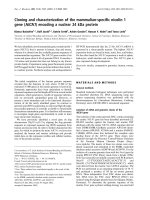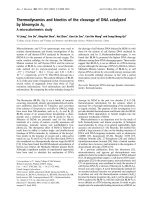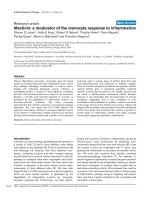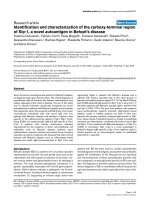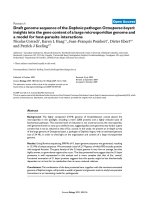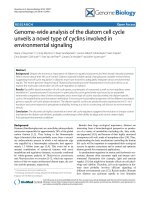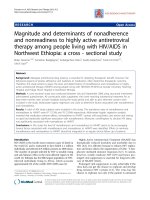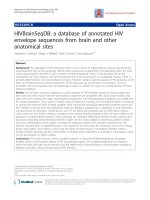Báo cáo y học: "Mactinin: a modulator of the monocyte response to inflammation" pps
Bạn đang xem bản rút gọn của tài liệu. Xem và tải ngay bản đầy đủ của tài liệu tại đây (313.61 KB, 7 trang )
R310
Introduction
α-Actinin is an actin-binding cytoskeletal protein present in
a variety of cells [1] and in focal adhesion sites where
cells adhere to the substrate [2]. There is biochemical [3]
and histologic [4] evidence that focal adhesion com-
plexes, containing α-actinin and other footpad material,
are left behind as a result of normal movement of cells [2],
perhaps at increased rates when neutrophils and mono-
cytes move into inflammatory tissue. We have shown that
α-actinin is abundant in the bone marrow stroma matrix,
presumably at focal adhesion sites [5]. We have also
reported that a 31 kDa amino-terminal α-actinin fragment,
which we have named mactinin, is generated by the
degradation of extracellular α-actinin by monocyte-
secreted urokinase [6]. Furthermore, we have demon-
strated that mactinin is present in inflammation caused by
Pneumocystis carinii pneumonia, by examining bron-
choalveolar lavage fluid from mice with infection [6]. It was
not present in mice not challenged with P. carinii, sug-
gesting that inflammaton is necessary for mactinin forma-
tion. We have also reported that mactinin promotes
monocyte/macrophage maturation [7]. For example, α-
actinin fragments significantly increase lysozyme secretion
and tartate-resistant acid phosphatase staining in periph-
eral blood monocytes. In contrast, intact α-actinin has no
maturation-promoting activity. We proposed that mactinin
is present in the microenvironment at sites of various types
of inflammation, perhaps owing to migrating cell popula-
tions, and there it might contribute to the recruitment and
maturation of monocytes.
GST = glutathione S-transferase; IACUC = Institutional Animal Care and Use Committee.
Arthritis Research & Therapy Vol 5 No 6 Luikart et al.
Research article
Mactinin: a modulator of the monocyte response to inflammation
Sharon D Luikart
1
, Hollis E Krug
1
, Robert D Nelson
2
, Timothy Hinkel
1
, Peter Majeski
1
,
Pankaj Gupta
1
, Maren L Mahowald
1
and Theodore Oegema
3
1
Department of Medicine, Veterans Affairs Medical Center and University of Minnesota, Minneapolis, Minnesota, USA
2
Ramsey Burn Center, Regions Hospital, St Paul, Minnesota, USA
3
Department of Biochemistry, Rush University, Chicago, Illinois, USA
Corresponding author: Sharon Luikart (e-mail: )
Received: 14 Apr 2003 Revisions requested: 11 Jun 2003 Revisions received: 8 Jul 2003 Accepted: 11 Jul 2003 Published: 5 Aug 2003
Arthritis Res Ther 2003, 5:R310-R316 (DOI 10.1186/ar799)
This is an Open Access article: verbatim copying and redistribution of this article are permitted in all media for any purpose, provided this notice is
preserved along with the article's original URL.
Abstract
During inflammatory processes, monocytes leave the blood
stream at increased rates and enter inflammation tissue, where
they undergo phenotypic transformation to mature macro-
phages with enhanced phagocytic activity. α-Actinin, a
cytoskeletal protein, is present in focal adhesion complexes
and left in the microenvironment as a result of cell movement.
Mactinin, a 31 kDa amino-terminal fragment of α-actinin, is
generated by the degradation of extracellular α-actinin by
monocyte-secreted urokinase. We have previously
demonstrated that mactinin promotes monocyte/macrophage
maturation. We now report that 0.5–10 nM mactinin has
significant chemotactic activity for monocytes. Mactinin seems
to be present in inflammatory arthritis synovial fluid, because
affinity-purified antisera reacted with a protein of the expected
molecular mass in various types of arthritis fluids that were
immunoaffinity-purified and subjected to Western analysis.
Thus, six of seven samples from patients with psoriatic arthritis,
reactive arthritis, gout, or ankylosing spondylitis contained
mactinin at levels that are active in vitro. Initially, mactinin was
not found in affinity-purified rheumatoid arthritis samples.
However, it was detectable after the dissociation of immune
complexes, suggesting that it was complexed to anti-
microfilament auto-antibodies. In addition, mactinin was found
in the lavage fluid from the arthritic knee joints of rabbits with
antigen-induced arthritis and was absent from the contralateral
control knee fluids. We conclude that mactinin is present in
several types of inflammatory arthritis and might modulate
mononuclear phagocyte response to inflammation.
Keywords: arthritis, chemotaxis, inflammation, monocytes
Open Access
Available online />R311
Monocyte/macrophage infiltration has a key role in the
pathogenesis of chronic arthritis [8]. The release of pro-
inflammatory cytokines, chemokines, growth factors, and
enzymes by the synovial lining macrophages is important
for the onset, propagation, and flare of arthritic inflamma-
tion [9]. The finding that the number of synovial tissue
macrophages is correlated with joint destruction in
rheumatoid arthritis is evidence of their importance
[9,10]. Monocytes and macrophages are believed to have
a similar role in other chronic inflammatory joint diseases,
such as gout [11] and psoriatic arthropathy [12]. There-
fore in this study we assessed the effects of mactinin on
monocyte chemotaxis in vitro. We have also tested syn-
ovial fluid from patients with various types of arthritis,
including rheumatoid arthritis, psoriatic arthritis, reactive
arthritis, gout, and ankylosing spondylitis, for the pres-
ence of the monocyte/macrophage maturation-promoting
fragment, mactinin. We have also investigated whether
mactinin is present in the antigen-induced arthritis model
in rabbits [13,14]. Macrophages are believed to be
important in this model of rheumatoid arthritis [15,16],
and both the arthritic and control joint fluid can be tested
for mactinin.
Materials and methods
Source of mactinin
As described previously [6], a pGEX2 vector, encoding
the actin-binding domain, residues 2–269 of chicken
smooth muscle α-actinin, fused with the carboxy terminus
of glutathione S-transferase (GST) with an engineered
thrombin cleavage site, was kindly provided by Dr DR
Critchley of the University of Leicester, UK. Fusion protein
was expressed in Escherichia coli, and the cleavage prod-
ucts of the fusion protein were purified by affinity chro-
matography of cell extracts on immobilized glutathione.
The fusion protein was then cleaved with thrombin (Cal-
biochem, San Diego, CA) to yield the actin-binding
domain of α-actinin and the GST carrier. The cleavage
products were then separated by reverse-phase high-per-
formance liquid chromatography on a C-4 column [6].
SDS–PAGE demonstrated that the α-actinin fragment
was more than 90% of the total protein of pooled frac-
tions, with the remaining 10% being carrier GST. The cal-
culated molecular mass of this α-actinin fragment was
30,700 Da. In this report, both the active product of uroki-
nase degradation of α-actinin formed in vivo [6] and the
active recombinant actin-binding domain, which are of
similar molecular masses, will be referred to as mactinin.
Mactinin and GST routinely assay negative for protein
endotoxin with a Pyrotell chromogenic assay kit, which
can detect more than 0.25 endotoxin units/ml (Associates
of Cape Cod, Woods Hole, MA).
Isolation of peripheral blood monocytes
Mononuclear cells were isolated from buffy coat prepara-
tions of healthy blood donors by density gradient centrifu-
gation with Histopaque 1077 (Sigma). Contaminating red
cells were then lysed in distilled water, and the sample
was applied to an LS separation column with a magnetic
monocyte isolation kit in accordance with the manufactur-
er’s instructions (Miltenyi Biotec, Auburn, CA). This nega-
tive selection method resulted in a cell population
containing more than 90% monocytes as determined by
CD14 expression.
Chemotaxis assay
Cell migration was assessed by a 48-well micro-chemo-
taxis chamber (NeuroProbe, Gaithersburg, MD). An
aliquot of peptide was placed in the lower compartment,
and a suspension of monocytes (30,000–35,000) was
placed in the upper compartment of the well. The two
compartments were separated by a polyvinylpyrrolidone-
free polycarbonate filter with a pore size of 5 µm. The
chamber was incubated at 37°C for 90 minutes. At the
end of the incubation period the filter was removed, fixed,
and stained with a Hema 3 stain set (Fisher, Pittsburgh,
PA). The cells that migrated through the membrane pore
in three high-power fields (×400) were counted by light
microscopy. Three chamber membranes were counted for
each concentration.
Assessment of mactinin concentrations necessary for
HL-60 cell maturation
HL-60 myeloid leukemia cells were seeded at a density of
10
5
/ml and grown for 3 days in RPMI medium with
50 µg/ml gentamicin and 15% fetal calf serum at 37°C
and 5% CO
2
, in the presence of various concentrations of
recombinant mactinin. We have previously reported that
mactinin promotes monocyte maturation as measured by
morphology, non-specific esterase activity, and Fc rosette
formation in this leukemia cell line [7]. Here we report the
concentrations necessary to induce maturation as
measured by non-specific esterase staining used as a
maturation marker.
Antisera generation
To generate antisera with sensitivity for detecting mactinin,
purified recombinant chicken α-actinin peptide was modi-
fied by coupling with dinitrophenol [17] and injected into
two New Zealand white rabbits along with complete Fre-
und’s adjuvant, as described previously [6]. Boosts were
done with peptide and incomplete Freund’s adjuvant.
These animal studies were approved by the Institutional
Animal Care and Use Committee (IACUC) of the Min-
neapolis Veterans Affairs Medical Center. Antisera were
screened for their ability to detect the immunizing peptide
and were immunoaffinity-purified with columns of the
recombinant fragment covalently bound to a Affi-Gel 15
matrix (Bio-Rad, Hercules, CA). We expected cross-reac-
tivity of the purified antisera with fragments from rats,
mice, or humans because of the highly conserved amino
acid sequence.
Arthritis Research & Therapy Vol 5 No 6 Luikart et al.
R312
Synovial fluid samples
Fluid from patients with arthritis undergoing therapeutic
arthrocentesis was collected and tested for the presence
of the fragment by Western blot analysis. The use of these
fluid samples in this study was approved by the subcom-
mittee on human studies of the Minneapolis VAMC. In brief,
fresh samples were centrifuged at 895g for 10 minutes
and frozen at –80°C until the time of analysis. Because
mactinin is a very small fraction of the total protein content
(more than 50 µg/10 µl) of the fluid, immunoaffinity purifica-
tion of mactinin was performed before Western blotting.
Samples were thawed, dialyzed against phosphate-
buffered saline, and centrifuged again; the total sample
volume was then applied to a column of immunoaffinity-
purified antibody covalently bound to a Affi-Gel 15 matrix,
and eluted with 0.1 M sodium citrate in 0.3 M NaCl,
pH 3.0. Fractions (2 ml) were collected and neutralized
with 2 M Tris-HCl. Protein-containing fractions were
pooled, dialyzed against phosphate-buffered saline, con-
centrated, and subjected to electrophoresis on a 12%
SDS–PAGE gel under reducing conditions. Each lane con-
tained 100 µl, representing about 1% of the total sample.
Immunoblot analysis
The proteins separated by SDS–PAGE were transferred
electrophoretically to poly(vinylidene difluoride) mem-
branes (Bio-Rad). The membrane was blocked with 5%
nonfat milk in 50 M Tris-HCl/150 M NaCl, pH 7.5, and
sequentially treated with affinity-purified rabbit antisera
raised against recombinant mactinin, followed by second
antibody conjugated with alkaline phosphatase (ICN,
Costa Mesa, CA). Immunoreactive proteins were detected
by alkaline phosphatase reaction with 5-bromo-4-chloro-3-
indoyl phosphate/nitroblue tetrazolium. Control analyses
were performed with rabbit IgG (Santa Cruz Biochemistry,
Santa Cruz, CA).
Dissociation of immune complexes in rheumatoid
arthritis fluid
To examine whether mactinin was present in immune com-
plexes in rheumatoid arthritis fluid, some samples were
acidified by dialysis against 0.1 M sodium acetate, pH 4.1,
to dissociate complexes [18]. The acidified samples were
first fractionated on an 800 ml G-75 Sephadex (Pharma-
cia, Piscataway, NJ) size-exclusion column. Fractions iden-
tified by Western blotting as containing mactinin were
pooled, neutralized, and further purified by fractionation on
a C-4 column. The C-4 column was equilibrated with
0.1% trifluoroacetic acid and eluted with an acetonitrile
gradient (0–100%) run at 1%/ml/min. Aliquots of protein-
containing fractions were used for Western blots.
Measurement of mactinin in the antigen-induced
arthritis model
To produce antigen-induced arthritis, New Zealand white
rabbits were immunized by subdermal injection of ovalbu-
min emulsified in complete Freund’s adjuvant in accor-
dance with modifications [14] of the method of Dumonde
and Glynn [13] under IACUC approval. Three weeks later,
animals with positive skin tests to ovalbumin received
intra-articular injections of 1 mg of sterile ovalbumin into
one knee and an equal volume of sterile saline in the con-
tralateral control knee weekly for 3 weeks. Arthritic and
control knee joints were then lavaged with saline and aspi-
rated at the time of killing, when animals had developed
chronic synovitis 10 weeks after the intraarticular injec-
tions were complete. Samples were frozen at –80°C until
the time of analysis. Samples were then concentrated and
used for Western blots.
Results
Mactinin is a chemoattractant for peripheral blood
monocytes
For analysis of the effect of mactinin on monocyte chemo-
taxis, peripheral blood monocytes were placed in the
upper chambers of a 48-well micro-chamber plate with
various concentrations of mactinin. The lower compart-
ment of the wells also contained various concentrations of
mactinin and was separated from the upper chamber by a
polycarbonate filter. As shown in Table 1, 1–10 nM mac-
tinin had significant chemotactic activity for monocytes.
Intact α-actinin at 10 nM had no activity. Because our
mactinin preparations were contaminated with up to 10%
GST (thus containing 0.1 nM GST in 1 nM mactinin), we
tested 0.1 nM GST alone and also found no activity. The
number of concentrations tested per assay was limited by
the 48 wells (16 combinations for triplicate wells), but in
separate assays we have seen significant chemotactic
activity at mactinin concentrations as low as 0.5 nM. The
concentration of mactinin necessary for activity is similar
to that of FMLP (0.1–10 nM) in our assay system, and
mactinin and FMLP attract similar numbers of monocytes.
Measurement of mactinin’s maturation-promoting
activity
Recombinant mactinin has maturation-promoting activity in
vitro in HL-60 leukemia cells at the concentrations shown
in Figure 1. That is, it induces non-specific esterase stain-
ing at 2.5 pM and activity reaches a plateau at 25 pM
(0.8 ng/ml). GST controls were run at a similar range of
concentrations and showed no significant activity.
Detection of mactinin in arthritis fluid
Affinity-purified rabbit antiserum raised against a recombi-
nant chicken α-actinin fragment detected picogram
amounts of the immunizing amino-terminal protein frag-
ment (Fig. 2). As also shown in Figure 2, this antiserum
reacted with a protein of the expected molecular mass in
representative samples of immunoaffinity-purified synovial
fluid from patients with psoriatic arthritis, reactive arthritis,
gout, and ankylosing spondylitis. In all, six of seven
samples from patients with these arthritides contained
Available online />R313
mactinin. In contrast, mactinin was detected in none of five
rheumatoid arthritis samples (P < 0.05; Fisher’s exact
test). When the detected levels of mactinin are corrected
for the recovery rate by the isolation procedure, they are
1.7–15 ng/ml, and are in the range of maturation-promot-
ing activity in vitro (≥ 25 pM or 0.8 ng/ml) and the level
needed for chemotactic activity (0.5 nM or 15 ng/ml). The
lack of mactinin in rheumatoid arthritis fluid was surprising,
and we decided to pursue this further.
Owing to the autoimmune nature of rheumatoid arthritis,
we examined whether mactinin was present in immune
complexes. That is, antibody-bound mactinin might not
bind to the antibody-matrix column used in the isolation
protocol to decrease the total protein load, resulting in
mactinin being undetectable but potentially active. To dis-
sociate immune complexes, an aliquot of a rheumatoid
arthritis fluid sample was acidified and the proteins were
fractionated on a C-4 column. As shown in Figure 3, mac-
tinin is detectable by Western blot analysis after dissocia-
tion from immune complexes.
To confirm the presence of mactinin in rheumatoid arthritis
fluids, some frozen aliquots were thawed and immediately
subjected to electrophoresis on a 12% SDS–PAGE gel
under reducing conditions. As shown in Figure 4, affinity-
purified mactinin antisera reacted with several 30–40 kDa
proteins, including 31 kDa mactinin in each of the samples
tested. We have previously demonstrated that only the
31 kDa α-actinin degradation product has maturation-pro-
moting activity [5]. These proteins were not seen in non-
reduced samples, which did have immunoreactive material
at the top of the gel (data not shown). Hence, the
Table 1
‘Checkerboard’ analysis of mactinin as a chemotactic factor
Mactinin concentration above membrane (nM)
Mactinin concentration
below membrane (nM) 0 0.1 1 10
0 21 ± 7 25 ± 8 17 ± 6 32 ± 10
0.1 25 ± 8 39 ± 12 21 ± 9 29 ± 5
1 70 ± 7* 77 ± 15* 48 ± 9* 28 ± 6
10 78 ± 7* 82 ± 19* NT 26 ± 7
Different concentrations of mactinin in the upper and lower compartments of chemotactic chambers define the ‘checkerboard’ analysis of mactinin
as a chemotactic or chemokinetic factor. Results (means ± SEM) are the average number of migrated cells per oil field (counting three fields) from
three filters. Significant results, compared with controls with no mactinin below the membrane and either an equivalent amount of mactinin or no
mactinin above the membrane by Student’s t-test, are indicated by asterisks (P < 0.05). This represents one of two experiments with similar results.
Neither 10 nM intact α-actinin nor 0.1 nM GST had significant activity. NT, not tested.
Figure 1
Percentage of HL-60 cells staining positive for nonspecific esterase
after treatment with various concentrations of recombinant mactinin.
Cells were incubated for 3 days with mactinin, then harvested and
stained. The percentage of untreated HL-60 cells positive for staining
was subtracted. Each value is the mean ± SD for a minimum of two
assays of 100 cells each. The result of treatment with 100 nM 12-O-
tetradecanoylphorbol-13-acetate is also shown (circle).
Figure 2
Western blot analysis with affinity-purified rabbit antisera. Each of the
first seven lanes contains the immunizing peptide in the amount shown
(in nanograms). The second band seems to be due to an alternative
cleavage site in the fusion protein at amino acid 262. Lanes A–E
contain synovial fluid from patients with various types of arthritis; it was
immunoaffinity-purified to decrease the protein load before Western
blotting. Lane A, psoriatic arthritis; lane B, reactive arthritis; lane C,
gout; lane D, ankylosing spondylitis; lane E, rheumatoid arthritis. The
samples in lanes A–D contained mactinin. Controls with rabbit IgG
were negative for all samples.
detected proteins might represent mactinin bound to
various immune complex fragments.
Mactinin is present in inflammatory fluid from antigen-
induced arthritis
Arthritic and control knee joints of rabbits with chronic
antigen-induced arthritis were lavaged with saline and aspi-
rated at the time of killing. Samples were concentrated and
used for Western blots run under reducing conditions. As
seen in Figure 5, mactinin is present in arthritis joint fluid
but absent from control fluid, suggesting that mactinin for-
mation is dependent on the inflammatory response. As also
seen in Figure 5, another α-actinin fragment of slightly
higher molecular mass is present in both samples.
Discussion
During inflammatory processes, various mediators, such
as cytokines and chemokines, regulate the recruitment of
monocytes. Once in the tissue, monocytes undergo the
poorly understood process of transformation to
macrophages with altered morphology and function [19].
In arthritis, synovial macrophages might cause joint
destruction by differentiating to bone-resorbing osteo-
clasts [20] or by releasing cartilage-degrading enzymes
and cytokines, such as interleukin-1 and tumor necrosis
factor-α [8]. It has therefore been suggested that thera-
pies for chronic arthritis should be aimed at depleting joint
mononuclear cells or controlling the activation of synovial
macrophages [21]. Indeed, elimination of macrophages by
clodronate-laden liposomes in rat models of adjuvant [22]
and antigen-induced arthritis [23] induces amelioration of
the arthritis.
Of the many mediators of inflammation, mactinin is the first
example of a fragment of a cytoskeletal component that
might be released during leukocyte influx into inflammatory
tissue. Further, mactinin might have a role in promoting the
response of mononuclear phagocytes to inflammation. The
monocyte functional studies in vitro demonstrate that
0.5–10 nM levels of the fragment have significant chemo-
tactic activity. We have previously reported that mactinin
promotes monocyte maturation, as measured by lysozyme
secretion and tartrate-resistant acid phosphatase staining
[7]. Here we show that 25 pM levels of mactinin promote
monocytic maturation of the HL-60 leukemia cell line.
Mactinin is present at sites of various types of arthritic
inflammation at levels that are active in vitro, including syn-
ovial fluid samples from patients with psoriatic arthritis,
reactive arthritis, gout, and ankylosing spondylitis.
Although it was not initially detected in five immunoaffinity-
purified rheumatoid arthritis samples, it was detected after
the acid dissociation of immune complexes. Girard and
Senecal [24] have reported that sera from patients with
autoimmune diseases such as rheumatoid arthritis contain
antibodies against microfilament-associated proteins,
including α-actinin. In addition, auto-antibodies against
actin, vinculin, integrins, or fibronectin could also form
complexes with mactinin [24,25]. Our results suggest that
mactinin is bound to immune complexes in rheumatoid
arthritis joint fluid, which prevents its binding to the anti-
body-matrix during the isolation procedure. The finding
that mactinin is detected by Western blotting of samples
run under reducing conditions without immunoaffinity
purification seems to confirm this. It is noteworthy that,
unless the antibody is neutralizing, even antibody-bound
mactinin might still be active.
Arthritis Research & Therapy Vol 5 No 6 Luikart et al.
R314
Figure 4
Western blot analysis of rheumatoid arthritis fluid. Synovial fluid (10 µl)
from two patients with rheumatoid arthritis was subjected to Western
blot analysis under reducing conditions.
Figure 5
Western blot analysis of synovial fluid of rabbits with antigen-induced
arthritis. Affinity-purified rabbit antisera raised against recombinant
mactinin was used to detect the immunizing protein in the amounts
shown in the first four lanes and mactinin from arthritic joint fluid in lane
A. Control joint fluid is shown in lane B.
Figure 3
Dissociation of immune complexes in rheumatoid arthritis fluid. An
aliquot of rheumatoid arthritis fluid was acidified to dissociate immune
complexes, then fractionated on a C-4 column before Western
immunoblotting (lane A). Another aliquot of the same sample (lane B)
was immunoaffinity-purified as in figure 2 but was not subjected to
immune complex dissociation.
The antigen-induced arthritis model of rheumatoid arthritis
in rabbits demonstrates persistent active inflammation for
several months after the intra-articular injection of antigen,
including hypertrophy and hyperplasia of the synovial
lining cells, pannus formation with articular cartilage
erosion, and chronic infiltration of synovium by lympho-
cytes and plasma cells [13]. In addition, Dijkstra and col-
leagues [15] found macrophages in the superficial layer of
the synovium, where they might secrete enzymes and
oxygen radicals into the joint space, which can lead to car-
tilage erosion [9]. The protein levels in lavage fluid from
arthritic joints in this model are low enough to allow direct
testing by Western blot analysis without immunoaffinity
purification, as was needed with the human aspirates.
Mactinin was found in the lavage fluid from arthritic knee
joints of rabbits with this immune arthritis and might con-
tribute to macrophage function in this arthritis model.
Because this study was done using waste fluid from thera-
peutic synovial fluid aspirates, we did not have samples
from noninflamed joints. The low mactinin recovery rate
during the purification process and the low concentration
of mactinin needed for activity make it necessary to assay
at least 1 ml of fluid, and this amount is not available from
any tissue and fluid bank. However, mactinin was not
present in the control joint fluid in the rabbit antigen-
induced arthritis model, suggesting that mactinin is spe-
cific for the inflammation process. Similarly, we have
reported that bronchoalveolar lavage fluid from uninfected
mice contains no mactinin, in contrast to fluid from mice
infected with P. carinii [6].
The plasminogen activators, tissue type and urokinase
type, have been reported to be both deleterious in inflam-
mation, owing to the proteolysis of tissue proteins, and
beneficial because of fibrinolytic activity [26]. The pres-
ence of both increased urokinase and plasmin inhibitors in
rheumatoid arthritis synovial tissue suggests a complex
role for urokinase in this disease [27–29] that seems perti-
nent to our finding of urokinase-generated mactinin in the
arthritis fluid samples. The overall effect of urokinase in the
antigen-induced arthritis model seems to be beneficial,
because chronic joint inflammation and bone erosion are
significantly worse in urokinase-deficient mice [30].
However, the ability of urokinase-generated mactinin to
enhance proteolysis might be deleterious. Hence, future
testing of specific mactinin inhibitors in animal models of
arthritis seems warranted.
Conclusion
We conclude that mactinin is present in arthritic synovial
fluid in levels that can promote mononuclear phagocyte
chemotaxis and maturation. There, increased numbers of
mature monocytes might increase cartilage and bone
destruction. These results lead us to speculate that
inhibitors of mactinin might be of benefit in the treatment
of some forms of chronic arthritis and form the basis for
our plans to test the efficacy of mactinin antisera to
ameliorate antigen-induced arthritis.
Competing interests
None declared.
Acknowledgements
This study was supported by the Department of Veterans Affairs.
References
1. Imamura M, Masaki T: Identification of 115-kDa protein from
muscle tissues: expression of a novel non-muscle
αα
-actinin in
vascular endothelial cells. Exp Cell Res 1994, 211:380-390.
2. Burridge K, Fath K, Kelly T, Nuckolls G, Turner C: Focal adhesions:
transmembrane junctions between the extracellular matrix and
the cytoskeleton. Annu Rev Cell Biol 1988, 4:487-525.
3. Culp LA: Electrophoretic analysis of substrate-attached pro-
teins from normal and virus-transformed cells. Biochemistry
1976, 15:4094-4104.
4. Chen WT: Induction of spreading during fibroblast movement.
J Cell Biol 1979, 81:684-691.
5. Masri M, Wahl D, Oegema T, Luikart S: HL-60 cells degrade
αα
-
actinin to produce a fragment that promotes monocyte/
macrophage maturation. Exp Hematol 1999, 27:345-352.
6. Luikart SD, Mastri M, Wahl D, Hinkel T, Beck JM, Gyetko MR,
Gupta P, Oegema T: Urokinase is required for the formation of
mactinin, an
αα
-actinin fragment that promotes monocyte/
macrophage maturation. Biochim Biophys Acta 2002, 1591:99-
107.
7. Luikart S, Wahl D, Hinkel T, Masri M, Oegema T: A fragment of
αα
-actinin promotes monocyte/macrophage maturation in
vitro. Exp Hematol 1999, 27:337-344.
8. Van Den Berg WB, Van Lent LEM: The role of macrophages in
chronic arthritis. Immunobiol 1996, 195:614-623.
9. Yanni G, Whelan A, Feighery C, Bresnihan B: Synovial tissue
macrophages and joint erosion in rheumatoid arthritis. Ann
Rheum Dis 1994, 53:39-44.
10. Mulherin D, Fitzgerald O, Bresnihan B: Synovial tissue
macrophage populations and articular damage in rheumatoid
arthritis. Arthritis Rheum 1996, 39:115-124.
11. Schweyer S, Hemmerlein B, Radzun HJ, Fayyazi A: Continuous
recruitment, co-expression of tumour necrosis factor-
αα
and
matrix metalloproteinases, and apoptosis of macrophages in
gout tophi. Virchows Arch 2000, 437:534-539.
12. Nishibu A, Han GW, Iwatsuki K, Matsui T, Inoue M, Akiba H,
Kaneko R, Kaneko F: Overexpression of monocyte-derived
cytokines in active psoriasis: a relation to coexistent arthropa-
thy. J Dermatol Sci 1999, 21:63-70.
13. Dumonde DC, Glynn LE: The production of arthritis in rabbits
by an immunological reaction to fibrin. Br J Exp Pathol 1962,
43:373-383.
14. Mahowald ML, Peterson L, Raskind J, Raddatz DA, Shafer R,
Gerding D: Antigen-induced experimental septic arthritis in
rabbits after intraarticular injection of staphylococcus aureus.
J Infect Dis 1986, 154:273-282.
15. Dijkstra CD, Dopp EA, Vogels IMC, Van Noorden CJF:
Macrophages and dendritic cells in antigen-induced arthritis.
Scand J Immunol 1987, 26:513-523.
16. Idogawa H, Imamura A, Onda M, Umemura T, Ohashi M: Progres-
sion of articular destruction and the production of tumor
necrosis factor-
αα
in antigen-induced arthritis in rabbits. Scand
J Immunol 1997, 46:572-580.
17. Harlow E, Lane D: Immunizations. In Antibodies: A Laboratory
Manual. Edited by Harlow E, Lane D. Cold Spring Harbor, NY:
Cold Spring Harbor Laboratory; 1988:124-125.
18. Johnson S, Opstad NL, Douglas JM Jr, Janoff EN: Prolonged and
preferential production of polymeric immunoglobulin A in
response to Streptococcus pneumoniae capsular polysaccha-
raides. Infect Immun 1996, 64:4339-4344.
19. Weinberg JB: Mononuclear phagocytes. In Wintrobe’s Clinical
Hematology. Edited by Lee GR, Foerster J, Lukens J, Paraskevas
F, Greer JP, Rodgers GM. Baltimore, MD: Williams & Wilkins;
1999:377-414.
Available online />R315
20. Fujikawa Y, Sabokbar A, Neale S, Athanasou NA: Human osteo-
clast formation and bone resorption by monocytes and syn-
ovial macrophages in rheumatoid arthritis. Ann Rheum Dis
1996, 55:816-822.
21. Barrera P, Blom A, van Lent PLEM, van Bloois L, Beijnen JH, van
Rooijen N, de Waal Malefijt MC, van de Putte LB, Storm G, van
den Berg WB: Synovial macrophage depletion with clo-
dronate-containing liposomes in rheumatoid arthritis. Arthritis
Rheum 2000, 43:1951-1959.
22. Kinne RW, Schmidt-Weber CB, Hoppe R, Buchner E, Palombo-
Kinne E, Nümberg E, Emmrich F: Long-term amelioration of rat
adjuvant arthritis following systemic elimination of
macrophages by clondronate-containing liposomes. Arthritis
Rheum 1995, 38:1777-1790.
23. Richards PJ, Williams AS, Goodfellow RM, Williams BD: Liposo-
mal clodronate eliminates synovial macrophages, reduces
inflammation and ameliorates joint destruction in antigen-
induced arthritis. Rheumatology 1999; 38:818-825.
24. Girard D, Senécal JL: Anti-microfilament IgG antibodies in
normal adults and in patients with autoimmune diseases:
immunofluorescence and immunoblotting analysis of 201
subjects reveals polyreactivity with micro-filament-associated
proteins. Clin Immunol Immunopathol 1995, 74:193-201.
25. Senécal JL, Oliver JM, Rothfield N: Anticytoskeletal autoanti-
bodies in the connective tissue diseases. Arthritis Rheum
1985, 28:899-898.
26. Akassoglou K, Kombrinck KW, Degen, JL, Strickland S: Tissue
plasminogen activator-mediated fibrinolysis protects against
axonal degeneration and demyelination after sciatic nerve
injury. J Cell Biol 2000, 149:1157-1166.
27. Weinberg JB, Pippen AMM, Greenberg CS: Extravascular fibrin
formation and dissolution in synovial tissue of patients with
osteoarthritis and rheumatoid arthritis. Arthritis Rheum 1991,
34:996-1005.
28. Ronday HK, Smits HH, Van Muijen GN, Pruszczynski MS, Dolhain
RJ, Van Langelaan EJ, Breedveld, FC, Verheijen JH: Difference in
expression of the plasminogen activation system in synovial
tissue of patients with rheumatoid arthritis and osteoarthritis.
Br J Rheumatol 1996 35:416-423.
29. Busso N, Peclat V, So A, Sappino AP: Plasminogen activation in
synovial tissues: differences between normal, osteoarthritis,
and rheumatoid arthritis joints. Ann Rheum Dis 1997, 56:550-
557.
30. Busso N, Peclat V, Van Ness K, Kolodziesczyk E, Degen J, Bugge
T, So A: Exacerbation of antigen-induced arthritis in urokinase-
deficient mice. J Clin Invest 1998, 102:41-50.
Correspondence
Dr Sharon Luikart, Department of Medicine, Veterans Affairs Medical
Center, Minneapolis, MN 55417, USA. Tel: +1 612 467 4135; fax: +1
612 725 2149; e-mail:
Arthritis Research & Therapy Vol 5 No 6 Luikart et al.
R316

